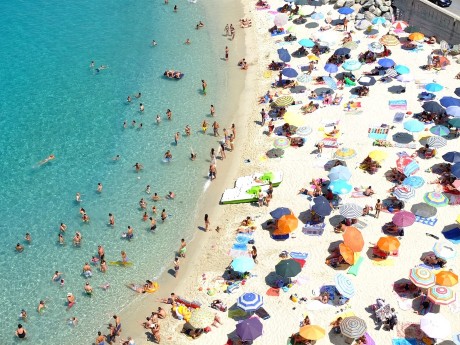Grand Southern Italy Tour
Embark on a journey through Southern Italy, where history, culture, and breathtaking landscapes await. Begin in Rome, the Eternal City, exploring iconic landmarks like the Colosseum, Roman Forum, and the Vatican. Discover the charm of Tropea, a coastal gem perched above the Tyrrhenian Sea, with stunning beaches and the serene Santuario di Santa Maria dell’Isola.
Read more
Embark on a journey through Southern Italy, where history, culture, and breathtaking landscapes await. Begin in Rome, the Eternal City, exploring iconic landmarks like the Colosseum, Roman Forum, and the Vatican. Discover the charm of Tropea, a coastal gem perched above the Tyrrhenian Sea, with stunning beaches and the serene Santuario di Santa Maria dell’Isola. Continue to Scilla, a town steeped in mythology, offering panoramic views of the Strait of Messina, followed by a visit to Reggio di Calabria to see the famous Riace Bronzes. Cross the Strait to Messina, Sicily’s vibrant gateway, then marvel at the ancient ruins of Taormina, with its Greek Theatre and views of Mount Etna. Explore Catania, a city at the foot of the volcano, blending Baroque architecture with dramatic landscapes. Conclude in Syracuse, where the ancient ruins of Neapolis and the charming island of Ortigia offer a peaceful and historic escape. A journey filled with unforgettable experiences and timeless beauty. Waterviews strives to offer accommodation options within walking distance of water and/or in an area of touristic interest. Our prices include taxes (but excludes local tourist taxes). Customize your trip to your personal preferences with optional activities (hit the “Add Activities’’) or change hotels, etc. Contact us for customization at no extra cost at: Service@waterviewstravel.com
Destinations
- Rome
- Tropea
- Scilla
- Reggio di Calabria
- Messina
- Taormina
- Catania
- Syracuse
- Rome
Itinerary
Rome
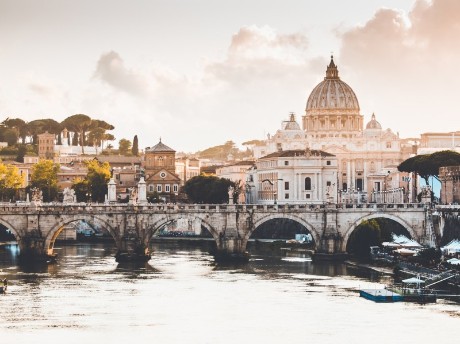
From the ancient walls of the Colosseum and the magic of the Trevi Fountain to the gilded churches of the Vatican City and the views from its seven hills, Rome is truly a dream. Stroll through the vibrant streets and you’ll get a taste for the city’s incredible past and rich culture, with ancient churches, Roman ruins and opulent fountains on every corner. And the city not only offers sightseeing - do as the locals and meander in piazzas, sample incredible street food and stop for an evening aperitivo to really experience la dolce vita.
Read more
From the ancient walls of the Colosseum and the magic of the Trevi Fountain to the gilded churches of the Vatican City and the views from its seven hills, Rome is truly a dream. Stroll through the vibrant streets and you’ll get a taste for the city’s incredible past and rich culture, with ancient churches, Roman ruins and opulent fountains on every corner. And the city not only offers sightseeing - do as the locals and meander in piazzas, sample incredible street food and stop for an evening aperitivo to really experience la dolce vita.
Additional Information
Situated on the River Tiber, between the Apennine Mountains and the Tyrrhenian Sea, the "Eternal City" was once the administrative centre of the mighty Roman Empire, governing a vast region that stretched all the way from Britain to Mesopotamia. Today it remains the seat of the Italian government and home to numerous ministerial offices. Rome has 2.7 million inhabitants while the metropolitan area is home to around 4.5 million.
Architecturally and culturally, Rome has some contrasts - you have areas with pompously huge majestic palaces, avenues and basilicas, which are then surrounded by tiny alleyways, little churches and old houses. The centre of Rome is mainly ancient, and modern buildings are usually concentrated in the suburbs, unlike Milan (where new and old architecture is combined both in the centre and the outskirts). You may also find yourself walking from a grand palace and tree-lined elegant boulevard, into a small and cramped Medieval-like street.
The abbreviation "S.P.Q.R" is ubiquitous in Rome, short for the old democratic motto "Senatus Populusque Romanus" (Latin), i.e. "The Roman Senate and People".
For two weeks in August, many of Rome's inhabitants shut up shop (literally) and go on their own vacations; many stores, restaurants and other amenities will be closed during this time. The temperature in the city centre at this time of year is not particularly pleasant. If you do travel to Rome at this time, be prepared to see Chiuso per ferie (Closed for holidays) signs on many establishments. Even in these weeks the city is very beautiful and if you are looking for a less overcrowded vacation in Rome, this is not a bad time. You will always be able to find somewhere to eat.
History
Rome's history spans over two and half thousand years, which have seen its transformation from a small Latin village to the centre of a vast empire, through the founding of Catholicism, and into the capital of today's Italy. Rome's history is long and complex. What follows is merely a quick summary.
Rome is traditionally thought to have been founded by the mythical twins Romulus and Remus, who were abandoned as infants in the Tiber River and raised by a mother wolf before being found by a shepherd who raised them as his own sons. Rome was founded as a small village sometime in the 8th century BC surrounding the Palatine Hill, including the area where the Roman Forum is found. Due to the village's position at a ford on the Tiber River, Rome became a crossroads of traffic and trade.
The settlement developed into the capital of the Roman Kingdom, led by a series of Etruscan kings, before becoming the seat of the Roman Republic at around 500 BC, and then the centre of the Roman Empire from 27 BC on. For almost a thousand years, Rome was the largest, wealthiest, most powerful city in the Western World, with dominance over most of Europe and the Mediterranean Sea. Even after the fall of the Roman Empire in the 5th century AD, Rome maintained considerable importance and wealth.
Beginning with the reign of Constantine I, the Bishop of Rome (later known as the Pope) gained political and religious importance, establishing Rome as the centre of the Catholic Church. During the Early Middle Ages, the city declined in population but gained a new importance as the capital of the newly formed Papal States. Throughout the Middle Ages, Rome was a major pilgrimage site and the focus of struggles between the Holy Roman Empire and the Papacy.
With the Italian Renaissance fully under way in the 15th century, Rome changed dramatically. Extravagant churches, bridges, and public spaces, including a new Saint Peter's Basilica and the Sistine Chapel, were constructed by the Papacy so that Rome would equal the grandeur of other Italian cities of the period. As the Grand Tour became customary for young European gentlemen in the 17th century, Rome became an important tourist destination, and remains as such until today.
In the 19th century, Rome again became the focus of a power struggle with the rise of the Kingdom of Italy, which wished to see a reunification of Italy. The Papal States remained in control of Rome under French protection, but with the outbreak of the Franco-Prussian War of 1870, French troops were forced to abandon Rome, leaving it clear for the Kingdom of Italy to capture. Rome became the capital of Italy, and has remained such ever since.
Rome today is a contemporary metropolis that reflects the many periods of its long history - Ancient times, Middle Ages, the Renaissance and the Modern Era. With the rise of Italian Fascism following World War I, Rome's population grew. This trend was stopped by World War II, which dealt relatively minor damage to Rome. With the dismantlement of the monarchy and the creation of the Italian Republic following WWII, Rome again began to grow in population and became a modern city. The city stands today as the capital of Italy and one of the world's major tourist destinations.
Climate
Rome has a Mediterranean climate, with hot, dry summers and mild, wet winters. In the winter months, daytime temperatures are usually pleasant and range from 10-15 °C, while nighttime temperatures tend to stay slightly above freezing. That being said, the occasional cold snap can cause temperatures to fall below freezing, and it is not unheard of for light flurries of snow to fall on occasion, though accumulation is rare, and major snowstorms are known to occur once every 20-25 years.
Background reading
At last count there were close to 1700 novels set in Rome in days gone by. Most easily available in bookshops are those by [http://lindseydavis.co.uk/ Lindsey Davis and Steven Saylor. Both are good storytellers and excellent at portraying life in Ancient Rome. Particularly interesting if you are visiting Rome may be Saylor’s Roma: The Novel of Ancient Rome, which traces the first thousand years or so of Rome’s history by following the fictional fortunes of two families. Each chapter begins with a map showing the state of Rome’s development at the time of the chapter.
The classic work on Ancient Rome remains Edward Gibbon’s History of the Decline and Fall of the Roman Empire. This was written in 1782 but is still being reprinted. A marvelous book that covers Rome’s fortunes from Romulus and Remus to the 1970s is Rome: The Biography of a City by Christopher Hibbert (Penguin). An excellent guide book, too, although perhaps a bit too heavy to carry around. Rome by Robert Hughes (Orion Books) concentrates on the city's art history and provides fascinating insights into the things you will see while walking around. SPQR, written by Cambridge University professor and British TV personality Mary Beard, and published in 2015, offers a detailed analysis of Rome's first 1000 years and attempts to answer why Rome expanded from a small village on the Tiber to the centre of a major empire.
English-language bookshops in Rome are: The Lion Bookshop, Via dei Greci, 36, close to Piazza di Spagna. Lots of books and a small cafe. Anglo-American Bookstore, Via delle Vite, 102, also close to Piazza di Spagna. A large store, with specialist sections. Strong on non-fiction. The Almost Corner Bookshop, Via del Moro 45, Trastevere. Small but very well-stocked store on the other side of the river. Some Italian bookstores also have English-language sections. Try the large selection of English books (but also French, Spanish and more) at Feltrinelli International in via Vittorio Emanuele Orlando - or the smaller selection at its store in Largo Argentina.
© Sourced from Wikivoyage
Tropea
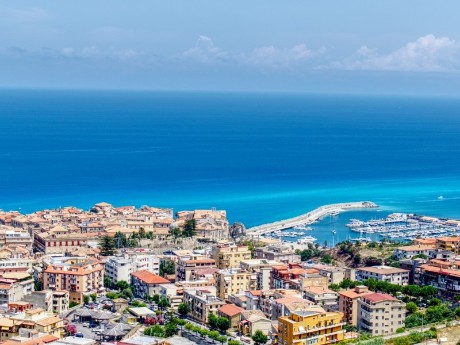
Tropea is a breathtaking sight, its rustic buildings perched upon a clifftop overlooking the turquoise waters of the Tyrrhenian Sea. The historic centre is a maze of cobbled lanes and charming squares that house ancient churches, bustling cafes and authentic restaurants, and down below you’ll find tropical-esque beaches that boast pristine white sands as well as dramatic cliffs and secluded coves. The imposing Santa Maria dell’Isola Sanctuary is a must-visit, from where you'll have scenic views over Tropea and as far as the Aeolian Islands.
Read more
Tropea is a breathtaking sight, its rustic buildings perched upon a clifftop overlooking the turquoise waters of the Tyrrhenian Sea. The historic centre is a maze of cobbled lanes and charming squares that house ancient churches, bustling cafes and authentic restaurants, and down below you’ll find tropical-esque beaches that boast pristine white sands as well as dramatic cliffs and secluded coves. The imposing Santa Maria dell’Isola Sanctuary is a must-visit, from where you'll have scenic views over Tropea and as far as the Aeolian Islands.
Scilla
On the tip of Italy's toe, just across the sea from Sicily, is Reggio di Calabria, a bustling port and the oldest city in the region. Despite its rich history which traces back to Ancient Greece, much of its sites were ruined in the 1908 earthquake and were rebuilt in a modern style. The main draw is the Magna Grecia National Museum, home to some of the most important historical artefacts of the region, and visitors can sample some of the best traditional cuisine of Calabria and stroll along the picturesque seaside with views over Mt. Etna.
Reggio di Calabria

On the tip of Italy's toe, just across the sea from Sicily, is Reggio di Calabria, a bustling port and the oldest city in the region. Despite its rich history which traces back to Ancient Greece, much of its sites were ruined in the 1908 earthquake and were rebuilt in a modern style. The main draw is the Magna Grecia National Museum, home to some of the most important historical artefacts of the region, and visitors can sample some of the best traditional cuisine of Calabria and stroll along the picturesque seaside with views over Mt. Etna.
Read more
The harbour city of Messina lies on the northeast corner of Sicily, and although often simply a stopover for visitors travelling from mainland Italy to the island, it offers a wealth of historic sights that makes it well worth the visit. Stroll through the city's elegant boulevards and bustling squares and you'll be enraptured by its charm, and be sure to stop at the Piazza del Duomo which houses the incredible Orion Fountain and a majestic Norman cathedral that enchants with its Gothic portal and intricate facade.
Messina
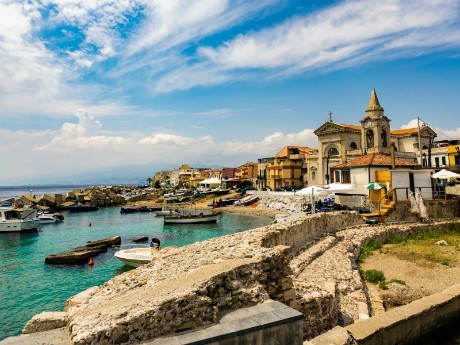
The harbour city of Messina lies on the northeast corner of Sicily, and although often simply a stopover for visitors travelling from mainland Italy to the island, it offers a wealth of historic sights that makes it well worth the visit. Stroll through the city's elegant boulevards and bustling squares and you'll be enraptured by its charm, and be sure to stop at the Piazza del Duomo which houses the incredible Orion Fountain and a majestic Norman cathedral that enchants with its Gothic portal and intricate facade.
Read more
Taormina is a spectacular hillside town, filled with historical jewels and with enchanting views over the Mediterranean and Mount Etna. The main draw is the ancient Greek Theatre which is worthy of a day trip in itself, yet time can simply be spent strolling through the evocative streets of the Old Town and watching the world go by in bustling piazzas. Venture down to the seaside and relax on Mazzarò beach, or spend an afternoon soaking up the sun on Isola Bella, connected to the mainland by a tiny strip of sand.
Additional Information
Taormina is a charming hillside town and is one of Sicily's most popular tourist resort. It can get very hot and busy during July and August, but the crowds melt away in the evenings. Early summer and autumn are ideal times to visit.
The TIC
Since 2011, the town service provider ASM (which runs the local buses, cable-car and parking lots) has been bankrupt. But it's been kept on financial & legal life-support ever since (ciao, welcome to Italy!), and in 2018 these services remain open.
Orientation
The main town of Taormina, which is what you've come to see, straggles along a hillside, 2 km up a hairpin road from the coast. The main access road is Via Luigi Pirandello (SP10), which leads to the bus station and Porta Messina at the east end of town. The pedestrianised high street Corso Umberto I stretches from here to Porta Messina at the west end. Bypass roads above and below carry the town traffic, while unseen and unheard deep beneath, the Messina-Catania Autostrada burrows through the mountain.
Above the main town, Via Leonardo da Vinci (SP10) continues to zigzag upwards, to Sanctuario Madonna della Rocca and the castle. And on it climbs, to end at the hilltop village of Castelmola. This is a separate township but it's such a tiny place, reached only by this road, that its facilities (such as they are) are described on this page.
The name "Taormina" is also loosely applied to the strip along the coast road SS114 below, notably to the railway station Taormina-Giardini-Naxos. Taormina town limits include the beach area of Mazzaro at the foot of the cable-car, and the tip of the peninsula where Via Pirandello starts its climb. Most package tourists stay down there, or in nearby resorts such as Giardini Naxos and Letojanni. Hoteliers down on the coast invoke the T-word to boost their prices, but for practical purposes - and considering the feel and identity of the place - they're altogether somewhere else. Stay in Taormina itself if you can.
© Sourced from Wikivoyage
Taormina
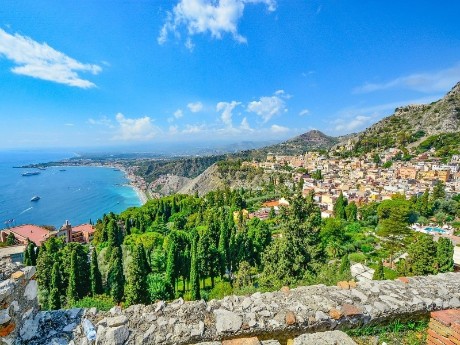
Taormina is a spectacular hillside town, filled with historical jewels and with enchanting views over the Mediterranean and Mount Etna. The main draw is the ancient Greek Theatre which is worthy of a day trip in itself, yet time can simply be spent strolling through the evocative streets of the Old Town and watching the world go by in bustling piazzas. Venture down to the seaside and relax on Mazzarò beach, or spend an afternoon soaking up the sun on Isola Bella, connected to the mainland by a tiny strip of sand.
Read more
The bustling city of Catania lies between the majestic Mount Etna and the cobalt blue Ionian Sea, boasting countless historic and cultural highlights as well as a vibrant atmosphere. The Piazza del Duomo houses an incredible Baroque cathedral and the iconic Elephant Fountain, and the charming streets of the historic centre are filled with ancient ruins, local markets, authentic restaurants and lively bars. The rustic charm and youthful energy here sets Catania apart from the rest of Sicily, making it a worthwhile stop on any itinerary.
Additional Information
The city has a history dating back 2,700 years, dominated by several different cultures (Greeks, Romans, Arabs, Normans, Spanish, etc.) and was a rich commercial centre, mainly due to its port. Again, since the 1970s, the city economy is growing as the urban area and the suburbs, making Catania a large metropolitan centre, mainly between the volcano and the sea. Today, even if you can find there most of the biggest commercial centers in Europe (especially Etnapolis), the 17th-century downtown area is still the center of the day-to-day life.
Catania sits under the most major active volcano in Europe and has been destroyed many times in the past. As a result, Catania is a city where you can find a great variety of landscape and architecture, a lot of dirty buildings and also a lot of abandoned houses, especially in the mountains. However, since the city is a World Heritage Site, a lot of renovations have been made.
Today, you will feel in Catania a mix of nostalgia and joie de vivre, especially at night or during festivals.
Sicilian Baroque
The major feature of this city is its architecture, which is predominantly baroque.
The major characteristic of Baroque architectural is its theatricality. This style dominated Europe in the 17th century as a result of the reformation/counter-reformation where the statement given was one of grandeur. The preceding style was Renaissance, while the succeeding was Neoclassicism. The three major features are a near excessive amount of detail (statues, lots of gold, columns and pilasters, garlands and wreaths etc.), façades which are taller than the nave (to fool the viewer of the size) and frescoes often featuring trompe-l'œil.
Baroque from Catania has several unique features such as use of dark lava stone (basalt), the Bell in the façade itself and grotesque masks and putti.
Tourist information
Info point of the province of Catania at the via Etnea.
© Sourced from Wikivoyage
Catania
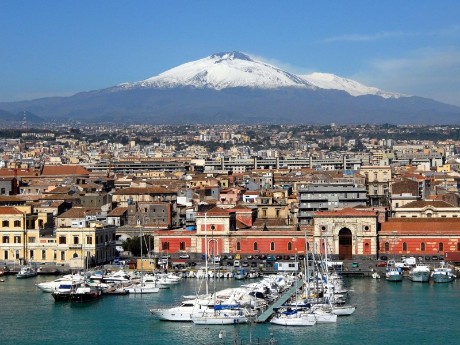
The bustling city of Catania lies between the majestic Mount Etna and the cobalt blue Ionian Sea, boasting countless historic and cultural highlights as well as a vibrant atmosphere. The Piazza del Duomo houses an incredible Baroque cathedral and the iconic Elephant Fountain, and the charming streets of the historic centre are filled with ancient ruins, local markets, authentic restaurants and lively bars. The rustic charm and youthful energy here sets Catania apart from the rest of Sicily, making it a worthwhile stop on any itinerary.
Read more
From the ancient walls of the Colosseum and the magic of the Trevi Fountain to the gilded churches of the Vatican City and the views from its seven hills, Rome is truly a dream. Stroll through the vibrant streets and you’ll get a taste for the city’s incredible past and rich culture, with ancient churches, Roman ruins and opulent fountains on every corner. And the city not only offers sightseeing - do as the locals and meander in piazzas, sample incredible street food and stop for an evening aperitivo to really experience la dolce vita.
Additional Information
Situated on the River Tiber, between the Apennine Mountains and the Tyrrhenian Sea, the "Eternal City" was once the administrative centre of the mighty Roman Empire, governing a vast region that stretched all the way from Britain to Mesopotamia. Today it remains the seat of the Italian government and home to numerous ministerial offices. Rome has 2.7 million inhabitants while the metropolitan area is home to around 4.5 million.
Architecturally and culturally, Rome has some contrasts - you have areas with pompously huge majestic palaces, avenues and basilicas, which are then surrounded by tiny alleyways, little churches and old houses. The centre of Rome is mainly ancient, and modern buildings are usually concentrated in the suburbs, unlike Milan (where new and old architecture is combined both in the centre and the outskirts). You may also find yourself walking from a grand palace and tree-lined elegant boulevard, into a small and cramped Medieval-like street.
The abbreviation "S.P.Q.R" is ubiquitous in Rome, short for the old democratic motto "Senatus Populusque Romanus" (Latin), i.e. "The Roman Senate and People".
For two weeks in August, many of Rome's inhabitants shut up shop (literally) and go on their own vacations; many stores, restaurants and other amenities will be closed during this time. The temperature in the city centre at this time of year is not particularly pleasant. If you do travel to Rome at this time, be prepared to see Chiuso per ferie (Closed for holidays) signs on many establishments. Even in these weeks the city is very beautiful and if you are looking for a less overcrowded vacation in Rome, this is not a bad time. You will always be able to find somewhere to eat.
History
Rome's history spans over two and half thousand years, which have seen its transformation from a small Latin village to the centre of a vast empire, through the founding of Catholicism, and into the capital of today's Italy. Rome's history is long and complex. What follows is merely a quick summary.
Rome is traditionally thought to have been founded by the mythical twins Romulus and Remus, who were abandoned as infants in the Tiber River and raised by a mother wolf before being found by a shepherd who raised them as his own sons. Rome was founded as a small village sometime in the 8th century BC surrounding the Palatine Hill, including the area where the Roman Forum is found. Due to the village's position at a ford on the Tiber River, Rome became a crossroads of traffic and trade.
The settlement developed into the capital of the Roman Kingdom, led by a series of Etruscan kings, before becoming the seat of the Roman Republic at around 500 BC, and then the centre of the Roman Empire from 27 BC on. For almost a thousand years, Rome was the largest, wealthiest, most powerful city in the Western World, with dominance over most of Europe and the Mediterranean Sea. Even after the fall of the Roman Empire in the 5th century AD, Rome maintained considerable importance and wealth.
Beginning with the reign of Constantine I, the Bishop of Rome (later known as the Pope) gained political and religious importance, establishing Rome as the centre of the Catholic Church. During the Early Middle Ages, the city declined in population but gained a new importance as the capital of the newly formed Papal States. Throughout the Middle Ages, Rome was a major pilgrimage site and the focus of struggles between the Holy Roman Empire and the Papacy.
With the Italian Renaissance fully under way in the 15th century, Rome changed dramatically. Extravagant churches, bridges, and public spaces, including a new Saint Peter's Basilica and the Sistine Chapel, were constructed by the Papacy so that Rome would equal the grandeur of other Italian cities of the period. As the Grand Tour became customary for young European gentlemen in the 17th century, Rome became an important tourist destination, and remains as such until today.
In the 19th century, Rome again became the focus of a power struggle with the rise of the Kingdom of Italy, which wished to see a reunification of Italy. The Papal States remained in control of Rome under French protection, but with the outbreak of the Franco-Prussian War of 1870, French troops were forced to abandon Rome, leaving it clear for the Kingdom of Italy to capture. Rome became the capital of Italy, and has remained such ever since.
Rome today is a contemporary metropolis that reflects the many periods of its long history - Ancient times, Middle Ages, the Renaissance and the Modern Era. With the rise of Italian Fascism following World War I, Rome's population grew. This trend was stopped by World War II, which dealt relatively minor damage to Rome. With the dismantlement of the monarchy and the creation of the Italian Republic following WWII, Rome again began to grow in population and became a modern city. The city stands today as the capital of Italy and one of the world's major tourist destinations.
Climate
Rome has a Mediterranean climate, with hot, dry summers and mild, wet winters. In the winter months, daytime temperatures are usually pleasant and range from 10-15 °C, while nighttime temperatures tend to stay slightly above freezing. That being said, the occasional cold snap can cause temperatures to fall below freezing, and it is not unheard of for light flurries of snow to fall on occasion, though accumulation is rare, and major snowstorms are known to occur once every 20-25 years.
Background reading
At last count there were close to 1700 novels set in Rome in days gone by. Most easily available in bookshops are those by [http://lindseydavis.co.uk/ Lindsey Davis and Steven Saylor. Both are good storytellers and excellent at portraying life in Ancient Rome. Particularly interesting if you are visiting Rome may be Saylor’s Roma: The Novel of Ancient Rome, which traces the first thousand years or so of Rome’s history by following the fictional fortunes of two families. Each chapter begins with a map showing the state of Rome’s development at the time of the chapter.
The classic work on Ancient Rome remains Edward Gibbon’s History of the Decline and Fall of the Roman Empire. This was written in 1782 but is still being reprinted. A marvelous book that covers Rome’s fortunes from Romulus and Remus to the 1970s is Rome: The Biography of a City by Christopher Hibbert (Penguin). An excellent guide book, too, although perhaps a bit too heavy to carry around. Rome by Robert Hughes (Orion Books) concentrates on the city's art history and provides fascinating insights into the things you will see while walking around. SPQR, written by Cambridge University professor and British TV personality Mary Beard, and published in 2015, offers a detailed analysis of Rome's first 1000 years and attempts to answer why Rome expanded from a small village on the Tiber to the centre of a major empire.
English-language bookshops in Rome are: The Lion Bookshop, Via dei Greci, 36, close to Piazza di Spagna. Lots of books and a small cafe. Anglo-American Bookstore, Via delle Vite, 102, also close to Piazza di Spagna. A large store, with specialist sections. Strong on non-fiction. The Almost Corner Bookshop, Via del Moro 45, Trastevere. Small but very well-stocked store on the other side of the river. Some Italian bookstores also have English-language sections. Try the large selection of English books (but also French, Spanish and more) at Feltrinelli International in via Vittorio Emanuele Orlando - or the smaller selection at its store in Largo Argentina.
© Sourced from Wikivoyage
Syracuse
Rome
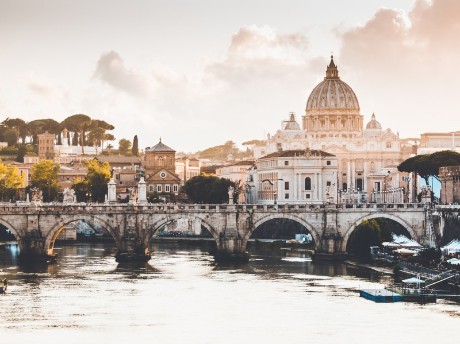
From the ancient walls of the Colosseum and the magic of the Trevi Fountain to the gilded churches of the Vatican City and the views from its seven hills, Rome is truly a dream. Stroll through the vibrant streets and you’ll get a taste for the city’s incredible past and rich culture, with ancient churches, Roman ruins and opulent fountains on every corner. And the city not only offers sightseeing - do as the locals and meander in piazzas, sample incredible street food and stop for an evening aperitivo to really experience la dolce vita.




